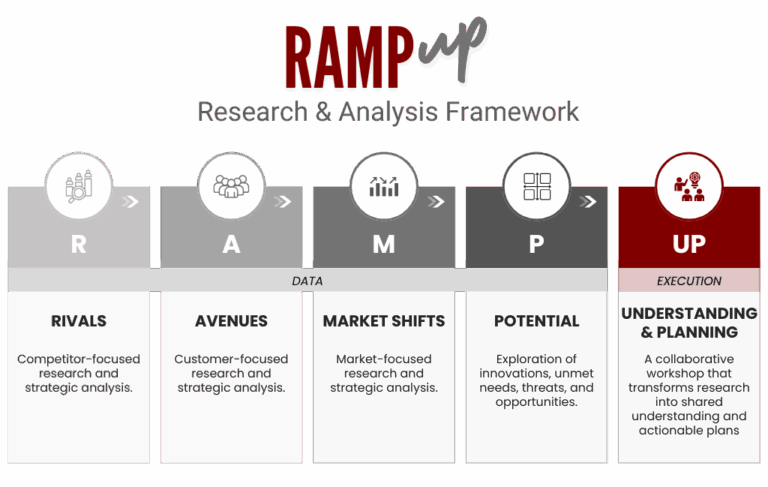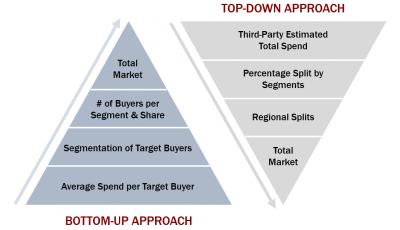Understanding your market size is one of the most critical steps in strategic planning. Since Michael Porter introduced the Five Forces, leaders have recognized that knowing the dimensions of your market shapes every significant business decision. Yet for many organizations, the difficulty is not in finding a rough estimate of total demand or knowing what percentage of the market share belongs to each segment. The real challenge lies in producing a market size calculation that is precise, defensible, and influential enough to guide investment priorities with confidence.
Market research, when executed with rigor, transforms raw numbers into strategic insight. A credible market size estimate should stand up to executive-level scrutiny and directly shape budget allocation, product roadmap design, and go-to-market strategies. Achieving this level of precision requires more than a downloaded report or a generic business analysis template. It demands a careful mix of primary research, competitive intelligence, and structured modeling techniques that consider every dimension of the opportunity.

Sedulo Group uses best-in-class intelligence gathering for market sizing and segmentation. This approach combines quantitative data analysis with direct market feedback to create market models that withstand scrutiny. It delivers segmentations that guide sales and marketing toward the most reachable and profitable customers, while also generating insights that reveal opportunities for sustained, long-term growth. This process sits within the Market Shifts pillar of our RAMP UP framework, which determines where demand exists today, where it is moving, and where a client’s next initiative should focus. Balancing statistical analysis with first-hand market intelligence, ensures that numbers are both accurate and actionable.
Defining Market Sizing and Segmentation
Market sizing is the process of estimating the total demand for a product or service within a defined market. A robust market size calculation begins with a clear understanding of who the customers are, what they value, and how they make purchasing decisions. Without this precision, even the most advanced calculation risks becoming misleading.
Defining the market starts with identifying the actual user, buyer, and competitor set. It involves clarifying the product’s use cases, revenue model, and position within the market landscape. This process blends customer interviews, competitor positioning analysis, internal stakeholder input, and a review of how different audiences perceive the offering. Once defined, the market boundaries should be tested against recognized classifications from investors, syndicated data providers, and consumer behavior research. For example, cereal and oatmeal may sit in different aisles, but both are classified within the breakfast foods market. Aligning on these boundaries ensures that market share analysis and market size estimates are comparable across sources.
Sizing the market often moves through three tiers: Total Addressable Market (TAM), Serviceable Available Market (SAM), and Serviceable Obtainable Market (SOM). TAM provides the broadest view of opportunity. SAM narrows this to the realistic portion a business can serve based on geography, product fit, or channel access. SOM focuses on the obtainable market share a company can realistically capture, taking into account competitive presence and operational capacity. Together, these tiers create a structured view of the theoretical, realistic, and achievable levels of demand.
Our approach blends top-down and bottom-up market research. Top-down analysis uses external data sources such as industry reports, government statistics, and economic indicators to provide directional sizing. Bottom-up analysis uses internal business data, including transaction volume, sales velocity, and average revenue per customer, to validate and refine those figures. Combining these perspectives yields a market size calculation that is both credible and grounded in reality.
Segmentation transforms market sizing into an actionable strategy. The goal is not only to divide the market into groups, but to identify which target audiences are most reachable, profitable, and underserved. Segmentation may be based on demographics, firmographics, geographic factors, decision-making dynamics, or behavioral patterns such as purchase frequency and urgency of need. In some cases, unconventional segmentation approaches provide the most insight, such as grouping consumers by whether they eat on the go or at home, or by nutritional priorities like protein versus carbohydrates or fats.
Real-World Market Size Examples and Customers
Never build market models in isolation. Every model is validated through primary research, including conversations with customers, competitors, partners, and subject matter experts. This ensures that the analysis reflects actual market conditions rather than theoretical assumptions.
In one corporate travel project, Sedulo Group segmented buyers not only by company size but also by the maturity of their internal travel processes. Win-loss interviews revealed a segment of mid-market companies with strong technology adoption but limited internal travel management resources. These organizations valued platform flexibility and rapid onboarding more than high-touch service. This insight reshaped product positioning, enabling the client to target a previously overlooked audience that represented significant obtainable market potential.
In another corporate travel engagement, our market research revealed that buyers in high-growth industries, such as biotech and software, were prioritizing traditional service metrics less. They wanted customizable workflows, fast implementation, and seamless integration with internal systems. This finding refined the client’s ideal customer profile, adjusted sales priorities, and repositioned their service to align with shifting demand.
The direct selling industry offers another example. At the top-line level, regional market data often conceals important patterns. A true SOM model here requires visibility into distributor behavior, tenure, and productivity, none of which are available from syndicated datasets. In one engagement, Sedulo Group built a bottom-up model layering distributor churn, average earnings, and tenure across regions. The results showed that the most attractive markets were not necessarily the largest by revenue, but those with high distributor loyalty and low competitive saturation. This level of detail allowed the client to reallocate resources from mature markets into agile, under-tapped regions where growth potential was far higher.
How to Begin Your Market Size Analysis
Any organization can apply a disciplined approach to market size calculation, even without extensive research budgets.
Begin by defining your market with precision. Speak directly with customers to understand their needs, pain points, and buying criteria. Consult internal sales and marketing teams for practical frontline insights. Analyze competitor positioning to understand both strengths and gaps in your own approach. Then compare your definition with how the market is classified by analysts, investors, or government data sources to ensure consistency.
When calculating market size, use a dual approach. Top-down estimates, drawn from industry research and macroeconomic data, provide directional guidance. Bottom-up calculations, using your own operational data such as sales velocity, average deal size, or retention rates, make the model defensible. The combination yields a more accurate and trustworthy view of the obtainable market.
Segmentation should go beyond static demographics. Incorporate behavioral patterns, purchasing motivations, and decision-making processes that directly influence sales outcomes. Look for ways to group customers by real-world similarities in how and why they buy. Even a small number of well-structured primary research interviews, whether with current customers, lost deals, or competitor clients, can surface insights that meaningfully change your understanding of market share distribution and opportunity sizing.
Why Precise Market Sizing Matters
Market size analysis is not an abstract exercise. It drives investment decisions, shapes product roadmaps, and guides the allocation of resources. Within the RAMP UP framework, it sits under Market Shifts because it identifies where demand is expanding, where it is contracting, and where the obtainable market offers the highest return on effort.
Accurate market size calculations, paired with meaningful segmentation, enable organizations to focus on the most promising target audiences. This clarity sharpens messaging, pricing, and channel strategies. In competitive environments where others pursue every lead with the same approach, this level of precision becomes a significant advantage.
The most effective strategies connect market size analysis directly to execution. A well-built model should reveal not only how large the market is, but also where your organization has the right to win, how much share you can realistically capture, and what steps will get you there fastest.
Key Market Size Calculation Takeaways and Next Steps
- Define a clear objective before starting. Whether validating market entry, prioritizing regions, or supporting a product launch, your goal determines the right approach.
- Combine top-down and bottom-up methods for a balanced and credible market size calculation.
- Ensure segmentation drives sales and marketing actions. If it does not influence decisions, it is not actionable.
- Incorporate primary research to validate and enhance the data.
- Tie market size findings directly to strategic decisions to ensure impact.
If your team needs a clear and confident view of where to focus and why, investing in precise market size and segmentation is one of the fastest ways to improve strategy and outcomes. Sedulo Group calculates market size, defines target audiences, and delivers insights that focus client resources to compete more effectively in the markets that matter most.
Contact us today to learn how our market research expertise transforms market data into sustainable growth.
Frequently Asked Questions About Market Size
What is market size?
Market size refers to the total potential demand for a product or service within a defined market. It is usually measured in revenue or units sold and is a key factor in strategic planning, investment decisions, and competitive positioning.
How do you calculate market size?
Market size calculation often combines top-down and bottom-up approaches. Top-down uses external market research, industry reports, and economic data to estimate total demand. Bottom-up uses internal business data such as sales volume, transaction frequency, and average revenue per customer to validate and refine those estimates.
What is the difference between TAM, SAM, and SOM?
TAM (Total Addressable Market) is the total possible market demand. SAM (Serviceable Available Market) is the portion of that market you can realistically target. SOM (Serviceable Obtainable Market) is the share you can actually capture based on your capabilities and competition.
Why does market size matter?
Understanding market size enables businesses to set realistic growth targets, allocate resources effectively, and prioritize the most profitable segments. It also supports better product development, marketing, and sales strategies.
How often should market size be updated?
Market size should be reviewed regularly, especially when launching new products, entering new markets, experiencing significant shifts in customer behavior, or facing changes in competitive dynamics.


